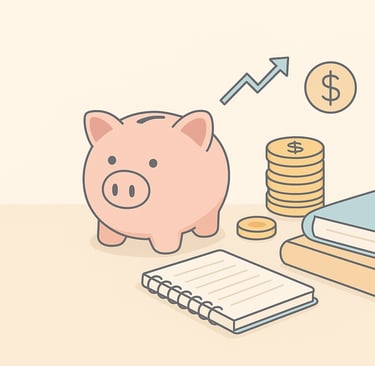Mastering Personal Finance: A Beginner’s Comprehensive Guide to Financial Freedom!!
Take control of your money, reduce stress, and build long-term wealth! This ultimate guide for beginners covers budgeting, saving, investing, debt management, financial mindset, and practical strategies to achieve financial independence.
11/4/20253 min read


Introduction: Why Financial Literacy Matters
Financial literacy is one of the most important skills for a successful life. Money affects almost every decision we make—from career choices to relationships, health, and long-term goals. Without understanding how to manage finances, it’s easy to fall into debt, stress, and missed opportunities.
By mastering personal finance, you:
Reduce stress and uncertainty
Gain control over your money and life decisions
Build wealth gradually through smart strategies
Achieve long-term financial freedom
This guide is designed for absolute beginners, but it also serves as a reference for anyone wanting a structured, practical approach to money management.
Step 1: Know Your Income and Expenses
Before making any plans, you need a clear picture of your finances.
1.1 Track Your Income:
List all income sources: salary, freelance work, rental income, dividends, etc.
Include irregular income for accurate planning.
1.2 Track Your Expenses:
Divide expenses into categories:
Essentials: Rent, utilities, groceries, insurance
Discretionary: Entertainment, hobbies, dining out
Savings & Investments: Emergency fund, retirement contributions
Practical Tip: Use a spreadsheet, notebook, or apps like Mint, YNAB, or even Google Sheets. Track expenses daily to see exactly where your money goes.
Step 2: Create a Smart Budget
Budgeting is a roadmap, not a restriction. A simple and popular method is the 50/30/20 rule:
50% Needs: Housing, groceries, bills
30% Wants: Entertainment, hobbies, dining out
20% Savings & Investments: Emergency fund, retirement, stocks
Pro Tip: If 50/30/20 doesn’t fit your reality, adjust percentages. The goal is to spend less than you earn consistently.
Step 3: Build an Emergency Fund
An emergency fund is your financial safety net. Life is unpredictable—job loss, medical emergencies, or sudden expenses can happen.
How to build it:
Start small: save $50–$100 monthly
Gradually aim for 3–6 months of essential living costs
Keep it in a high-yield savings account for accessibility
Example: If your monthly expenses are $1,000, your target emergency fund should be $3,000–$6,000.
Step 4: Manage and Reduce Debt
Debt can slow financial growth and cause stress. Prioritize paying off high-interest debt first:
Credit Cards: Often 20–30% APR
Payday Loans: Extremely high interest
Strategies:
Debt Snowball: Pay off smaller debts first to build momentum
Debt Avalanche: Pay off highest interest debts first to save money
Tip: Avoid new debt and focus on living below your means.
Step 5: Start Investing Early
Investing is essential for building wealth over time. Thanks to compound interest, even small investments grow significantly.
Investment Options for Beginners:
Stocks or ETFs: Gradually invest in the stock market
Mutual Funds: Professionally managed portfolios
Retirement Accounts: 401(k), IRA, or local equivalents
Practical Example:
Investing $100/month at 7% annual return over 30 years → approximately $100,000.
Tip: Diversify your portfolio to reduce risk. Never invest money you might need soon.
Step 6: Set Clear Financial Goals
Define short-term, medium-term, and long-term goals:
Short-term (0–1 year): Build emergency fund, pay off small debts
Medium-term (1–5 years): Save for a car, vacation, or home down payment
Long-term (5+ years): Retirement, passive income, financial independence
Tip: Make goals SMART: Specific, Measurable, Achievable, Relevant, Time-bound.
Step 7: Mindset and Habits
Financial success is built on habits and mindset:
Practice gratitude: Appreciate what you have before chasing more
Avoid impulse purchases: Pause before buying non-essentials
Continuously educate yourself: Read books, blogs, or take courses
Be patient and consistent: Wealth grows slowly, not overnight
Step 8: Track Progress and Adjust
Financial planning is ongoing. Review monthly:
Spending and budgeting accuracy
Savings growth and investment performance
Debt repayment progress
Adjust strategies as your life changes: new job, income changes, or new goals.
Step 9: Learn to Protect Your Money
Insurance: Health, life, car, and home insurance protect against major losses
Emergency planning: Wills, legal documents, and contingencies
Step 10: Build Multiple Income Streams
Relying on one income source is risky. Options:
Freelancing
Investing (dividends, stocks, real estate)
Online businesses or digital content
Even small additional income improves financial security and accelerates goals.
Conclusion
Financial literacy is not just about numbers—it’s about control, security, and freedom. By understanding your money, budgeting, saving, managing debt, investing, and maintaining a healthy financial mindset, you are laying the foundation for a secure and independent life.
Key Takeaways:
Start tracking and budgeting today
Build an emergency fund before big investments
Pay off high-interest debt first
Invest consistently and diversify
Set goals, track progress, and cultivate a disciplined mindset